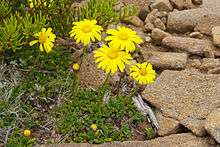Senecio pectinatus
Senecio pectinatus, commonly known as alpine groundsel, is a species of flowering plant in the aster family.[2] The species occurs in alpine areas of south-eastern Australia in peat-based soils.[3][4] It has divided leaves forming a basal rosette and produces a single yellow flower head (up to 30 mm diameter) on a stalk up to 20 cm high.[3]
| Senecio pectinatus | |
|---|---|
 | |
| In Walls of Jerusalem National Park, Tasmania | |
| Scientific classification | |
| Kingdom: | Plantae |
| Clade: | Tracheophytes |
| Clade: | Angiosperms |
| Clade: | Eudicots |
| Clade: | Asterids |
| Order: | Asterales |
| Family: | Asteraceae |
| Genus: | Senecio |
| Species: | S. pectinatus |
| Binomial name | |
| Senecio pectinatus | |
Two varieties are currently recognised:
- Senecio pectinatus var. major F.Muell. ex Belcher (Victoria and New South Wales)[5][6]
- Senecio pectinatus DC. var. pectinatus (Victoria and Tasmania)[5][7] It has small leaves with the tips of the divided segments curving inwards.[4]
A white-flowering variety (Senecio pectinatus var. ochroleucus F.Muell.) was promoted to species status in 2004 as Senecio albogilvus I.Thomps.[1]
References
- "Senecio pectinatus". Australian Plant Name Index (APNI), IBIS database. Centre for Plant Biodiversity Research, Australian Government, Canberra. Retrieved 10 January 2012.
- "Senecio pectinatus DC". Atlas of Living Australia. Retrieved 10 January 2012.
- "Senecio pectinatus (DC.) Benth". PlantNET - New South Wales Flora Online. Royal Botanic Gardens & Domain Trust, Sydney Australia. Retrieved 10 January 2012.
- "Senecio pectinatus (Asteraceae)". Key to Tasmanian vascular plants. University of Tasmania. Retrieved 10 January 2012.
- Walsh N.G and V. Stajsic. Census of the Vascular Plants of Victoria (Eighth Edition). Royal Botanic Gardens Melbourne. ISBN 978-0-9751362-8-7. Retrieved 10 January 2012.
- "Senecio pectinatus var. major F.Muell. ex Belcher". PlantNET - New South Wales Flora Online. Royal Botanic Gardens & Domain Trust, Sydney Australia. Retrieved 10 January 2012.
- "A Census of the vascular plants of Tasmania" (PDF). Archived from the original (PDF) on 20 July 2011. Retrieved 10 January 2012.
This article is issued from Wikipedia. The text is licensed under Creative Commons - Attribution - Sharealike. Additional terms may apply for the media files.